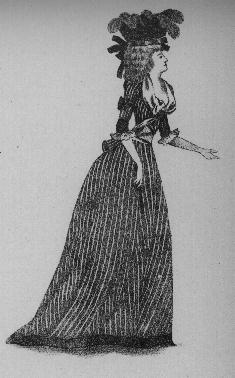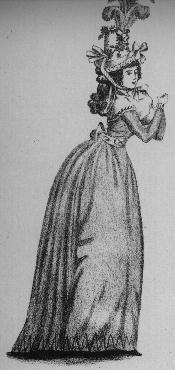



Boucher, Francois. Histoire du costume en occident de l'antiquite a nos jours. Paris: Flammarion, 1965.
Favier, Jean et al., eds. Chronicle of the French Revolution, 1788-1799. London: Chronicle Publications, 1989.
Ribeiro, Aileen. The Art of Dress: Fashion in England and Fracne 1750 to 1820. New Haven: Yale UP, 1995.
See, Raymonde. Le Costume de la Revolution a Nos Jours. Paris: Editions de la Gazette des Beaux-Arts, 1929.
Steele, Valerie. Paris Fashion: A Cultural History. New York: Oxford University Press, 1988.
"The Journal de la mode et du gout (1790-93) records the different ways in which clothing reflected a constantly shifting political situation and the nervous tensions in society" (Ribeiro 84).
 |
 |
| A simple white gown with ruffled hem is here covered by a patterned shawl on a white ground. | A dress made of a red-brown print is trimmed with green ribbon and lace at the hem. Red leather slippers peep out from the skirt. The same trim is at the cuff of the long, tight sleeves and the waist of the two-piece dress. The lady wears a necklace of peals and a cap trimmed with green garland and green-tipped red plumes. The lady's waist is clearly tightly corsetted. |
 |
 |
| Striped two-piece dress is worn by a tightly-corsetted woman. The neckline is low as well. The headdress is a massive profusion of plumes. | A high bonnet trimmed with flowers and plumes is worn by this lady. Her dress has a simple trim at the cuffs and hem. A sash draws attention to her small waist. Embroidery borders the kerchief of the dress. |
To Return to the Regency Publications Page